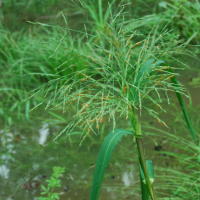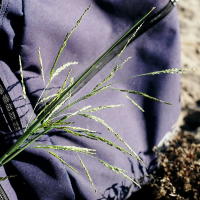Fall panicum
Panicum dichotomiflorum
Fall panicum is a fibrous-rooted annual grass that reproduces by seeds and grows up to 3 feet (90 cm) tall. Size varies greatly, depending on competition from other plants for soil moisture and nutrients. The stem often has a zigzag appearance because it bends at the joints (nodes); leaves emerge from the nodes in an alternate fashion. Fall panicum is basically an upright branching grass, but a portion of its outer stems often lie flat (decumbent habit). Roots grow from the enlarged lower nodes that touch the ground.
Leaf blades are lance-shaped, pointed (lanceolate), and have a prominent pale green midvein. Mature leaves are ½ to 1 inch (1.3 to 2.5 cm) wide and 6 to 18 inches (15 to 46 cm) long. Blades are dull on top and glossy underneath. The upper surface may be sparsely hairy, but both sides are usually smooth.
Fall panicum flowers from June to October and reproduces from seeds that mature in late summer and fall. The seed head grows 6 to 12 inches (15 to 30 cm) long and 3 to 6 inches (7. 5 to 15 cm) wide. It has a distinctive pyramid shape and long, wispy flower stalks borne on a single axis.
When shed from the plant, seeds are dormant, and require a cold period of three to four months before they can germinate. Germination begins in late April or early May, and continues throughout the summer. Maximum germination occurs at a soil temperature of 80 °F (27 °C). Plants that emerge early may produce ten times as much dry matter as plants that emerge in July, if competition from crops or other weeds is not severe. Peak growth takes place in late June and July, just before flowering.
Fall panicum grows in a diversity of habitats, including marshes, ditches, savannas, low woods, dry roadsides, and cultivated fields. It is a particular problem in corn and soybean crops, thrives in wet open areas of fields, and tolerates flooding.
















Plant Protection Products
- ⭑⭑⭑
- ⭑⭑⭑
- ⭑⭑⭑
- ⭑⭑⭑
- N/A
- ⭑⭑⭑
- ⭑⭑⭑
- N/A
- N/A
- ⭑⭑⭑
- ⭑⭑⭑
- N/A
- N/A
- ⭑⭑⭑
- N/A
- N/A
- ⭑⭑⭑
- N/A
- ⭑⭑⭑
- ⭑⭑⭑
- ⭑⭑⭑
- ⭑⭑⭑
- ⭑⭑⭑
- ⭑⭑⭑
- ⭑⭑⭑
- ⭑⭑⭑
- ⭑⭑⭑
- ⭑⭑⭑
- ⭑⭑⭑
- ⭑⭑⭑
- N/A
- N/A
- N/A
- N/A
- N/A
- ⭑⭑⭑
- N/A
- ⭑⭑⭑
- ⭑⭑⭑
- ⭑⭑⭑
- N/A
- N/A
- N/A
- ⭑⭑⭑
- ⭑⭑⭑
- ⭑⭑⭑
- ⭑⭑⭑
- ⭑⭑⭑
- N/A
- N/A
- ⭑⭑⭑
- N/A
- ⭑⭑⭑
- ⭑⭑⭑
- ⭑⭑⭑
- ⭑⭑⭑
- N/A
- N/A
- N/A
- N/A
- N/A
- N/A
- N/A
- ⭑⭑⭑
- ⭑⭑⭑
- ⭑⭑⭑
- ⭑⭑⭑
- ⭑⭑⭑
- ⭑⭑⭑
- ⭑⭑⭑
- N/A
- ⭑⭑⭑
- ⭑⭑⭑
- ⭑⭑⭑
- N/A
- N/A
- N/A
- N/A
- N/A
- N/A
- ⭑⭑⭑
- N/A
- N/A
- N/A
- N/A
- N/A
- N/A
- N/A
- N/A
- N/A
- N/A
- N/A
- N/A
- N/A
- N/A
- N/A
- N/A
- N/A
- N/A
- N/A